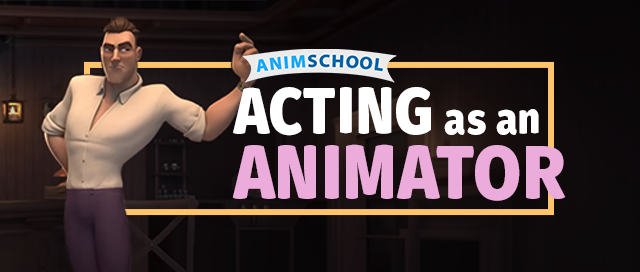
AnimSchool instructor Masha Juergens explores the process of getting into character from behind the camera.
Acting for animation is a unique art form, where animators bring characters to life not just with the use of technology, but through the use of their own physical and emotional performances. With boundless creativity, they craft compelling personalities that resonate with audiences of all ages, making animated worlds come alive on your screen.
Animators vs. Actors
- Animators focus on externals in characterization and caricature (facial expressions, body movement, emotional reaction, etc.)
- Actors, by contrast, learn specifically notto focus on these things because they are “results” – you cannot act results.
- As an animator, you must understand what your body is doing, what your emotional status is, etc., and translate all of that into a digital space and onto a model.
- The challenge comes from making your audience feel like your character is alive, not because they are moving around onscreen, but because they are thinking and have a personality that makes them unique!
- You don’t have to be a physically great actor to be a great actor in your mind, and in turn a great animator!

Becoming a Better Actor
To get better acting in your animations, you must become a better actor. Get into the head of your character – try to figure out and better understand where they are from, what their personality is, what their motivations are, etc. It’s not just about portraying a clear external (happy, sad, etc.) – try to look deeper for an internal feeling, or consciousness.
Identify the character’s emotional state and use the thought to drive the action, not the dialogue. When there is a change in the character’s emotional state, change the character’s main pose. Be careful here: don’t change poses simply because there is a new emphasis in the dialogue!
Adding Beats in Animation – Emotional Hang Time
When a character is feeling one emotion and something happens to make the character feel something else in the same shot, the character needs to have a moment to process before the emotional change can take place. Building beats into the animation can show that the character is mentally absorbing and processing the events that are occurring in the shot. These moments can be quick, but readability is key.
Watch the full excerpt from a live AnimSchool lecture below:
At AnimSchool, we teach students who want to make 3D characters move and act. Our instructors are professionals at film and game animation studios like Dreamworks, Pixar, Sony Pictures, Blizzard & Disney. Get LIVE feedback on your Animation from the pros.
Learn more at https://animschool.edu/

Leave a Reply